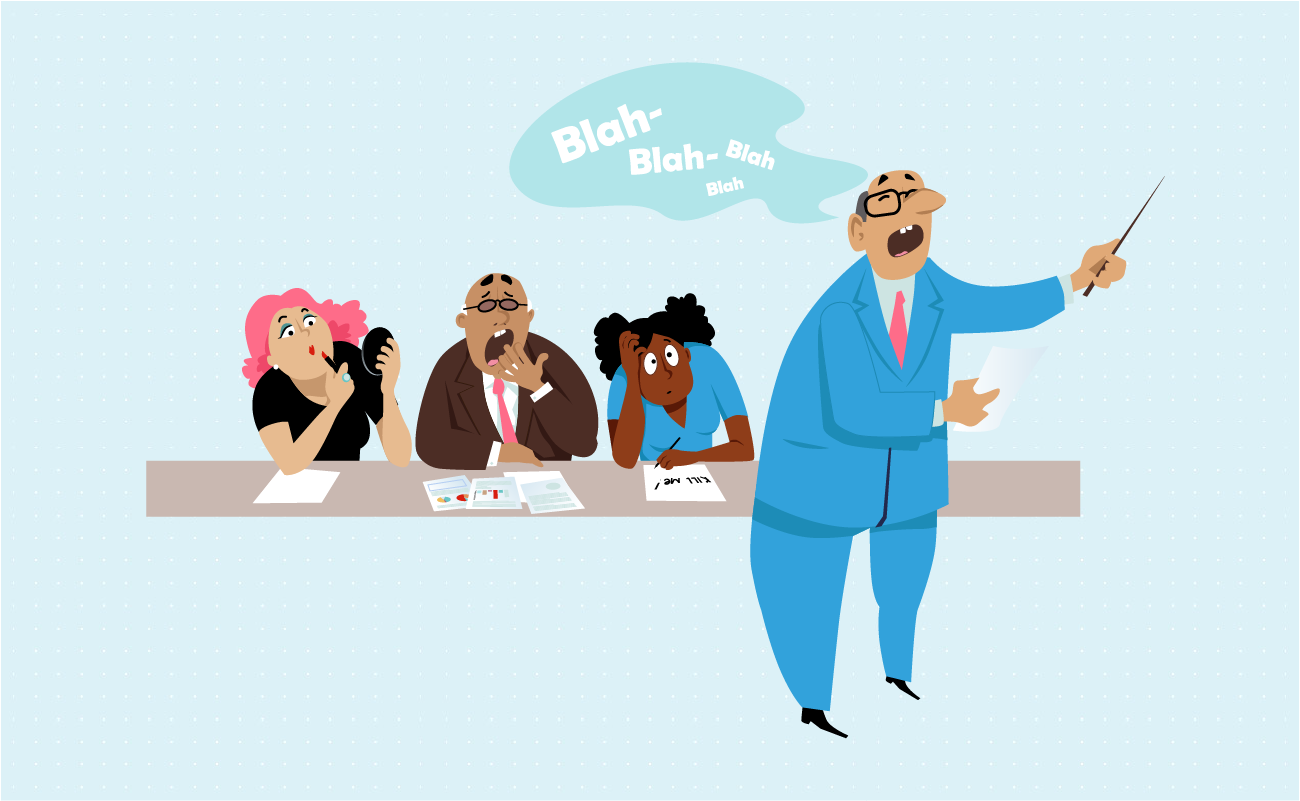 Business Meeting Cost Calculator
Business Meeting Cost CalculatorUse this calculator to estimate the annual cost of business meetings.
Guide published by Jose Abuyuan on March 4, 2020

We've all had that one boring office meeting. It's another dull morning or afternoon where nothing gets done. The boss comes in late. Nobody understands what the meeting is about. Some vague point gets thrown around. The smart-alecky guy at the back is playing buzzword bingo. You'd sooner be playing Candy Crush—or, better yet, do your actual job—than bother listening.
At the end of the day, the meeting goes over schedule. You go home, dreading the amount of work you'll have to do tomorrow to catch up. You start to question the necessity of holding that meeting during crunch time.
Sounds familiar? People across the globe lament the uselessness of meetings. This is not lost to policymakers, who point out the costs of this redundancy. In the U.S. alone, unproductive company meetings cost businesses over $37 billion in losses.
“Preparing for meetings may take up time that you should have dedicated to doing your actual job.”
Meetings are hardly the most productive uses of employee hours. A meeting is an interruption of the work cycle. They throw employees off their groove, which can affect work quality and productivity.
It isn't only because the meeting itself that takes too much time. Preparing for meetings may take up time that you should have dedicated to doing your actual job. Disengagement is also a problem. Many meetings are a chore to listen to. Sometimes, you realize that the conversation doesn't even concern your work at all.
Poorly planned meetings diffuse responsibility. Leaving things up for discussion creates delays. Business leaders risk wasting everyone's time rather than taking decisive action. And delayed action can cost just as much as the time wasted by holding the meeting.
With all their drawbacks, you might start to wonder why people insist on them.
Humans are social animals. We are more productive when we have others to banter with. By instinct, we prefer people to tell us things right in front of us, and with good reason. There is a nuance to human body language, vocal tone, and facial expressions. No machine can replace the communicative power of talking to another person in the same room.
This social reality is why we hold on to meetings. There are certain things that can only be conveyed to your group when you tell them in person. Some things cannot be left to the unfeeling ambiguity of the written word. Your body language can tell your employees more than your words ever will.

Most managers hold meetings to achieve a business objective. The six main reasons are as follows:
Effective meetings have a democratizing effect in a company. It allows individuals to connect with their group and share their thoughts and ideas. Many game-breaking new concepts can come from people who only need a turn at the mic. In addition, meetings also let employees share their views on major decisions.

Avoid tardiness. Start your meeting on the dot and finish on time. Murphy's law being what it is, you should always have contingencies. Assign someone likely to come early to start the meeting in your absence.

Regular daily meetings are popular with industries dependent on close-knit teams and the free flow of ideas. Morning huddles get everyone in a team on the same page. These early sessions also allow creative minds to share and refine ideas through discussion. Coworker feedback adds perspectives and ideas that you wouldn't have thought of if you worked alone.
Of all meeting types, everyday huddle-type meetings are the most effective. This is likely because they've become another part of the daily schedule. People know how long they should last. Managers also know better than to keep their teams hanging. They get to the point, and get stuff done. Now if only other meetings were like this.
The perception that meetings are a waste of time are reinforced by the actual flaws common in many of today's meetings. To make these meetings more effective, these must be corrected.
When it comes to meetings, less is more. Having fewer meetings causes less workflow interruptions. Making each of those meetings matter maximizes their benefit to the company. Holding an effective meeting on occasion can do the work of several boring meetings every week.
A lot of business meetings run for too long. Few meetings achieve anything of value past the two-hour mark. At this point, the listener's attention has long fatigued. And length isn't the only thing that undercuts a marathon meeting.
Long meetings run the risk of misappropriating time. You might give too much emphasis on seemingly urgent but trivial things. This steals the spotlight from more important matters. To avoid this, divide your agenda into key points. Each new point should have an appropriate amount of time dedicated for it.
If you have other speakers, give them enough time to say their piece. Always remember to designate a part of your schedule for quick questions from the audience. If you run out of time, send your last points through e-mail or save it for the next meeting.

Without a clear guideline, you risk going on many tangents during a meeting. Make sure that you explain everything in clear language. Don't let buzzword bingo become a meeting's high point.
Likewise, don't be vague with your agenda items. Being specific spurs listeners to look up the data themselves. This can save you time explaining data and terms. Decide early on if you want your pitch to be an idea or a command and tailor your presentation to that end.
If you think an attendee might not understand a key concept, approach them. It is better to talk to them sooner rather than later. Hold these discussions before the meeting begins.
Proper management is key to creating a clear discussion. If many people are talking, appoint a parliamentarian to time the speakers so they finish on the dot. Unless the meeting's job was to inform, end it with an actionable list for its listeners. Appoint someone to keep track of these assignments.

Meetings don't have to be rigid the whole way. Save unstructured discussions for last. While they might detract from your main agenda, these discussions can bring other important problems and issues to light.
A boring meeting wastes everyone's time. Its contents are not absorbed. Boredom also kills creativity and undercuts innovation. No one has the mental energy to think at the end of a two-hour stretch.
Staggering discussion can ease the meeting's effects on your attendee's attention spans. To foster engagement, hold the creative part of the meeting early. Doing so takes advantage of the crowd's mental energy. For long meetings, the most important item on the agenda should be at the middle of the discussion. This way, attention picks up at the lull point of the meeting.
Spice up the discussion with humor whenever appropriate. There's nothing wrong with breaking the ice with a joke or three, but don't stray too far off topic. Avoid small talk and boring anecdotes.
If you're holding a team-building meeting, try holding it somewhere unconventional. If the budget permits, treat your attendees out to somewhere nice. A change of atmosphere can be all they need to become mentally engaged. Fun also galvanizes a team. You turn coworkers into friends that way.
Many meetings end up with too many people attending. Incidentally, these are also the ones more likely to make people bored to death. Most meetings should be held with no more than 12 people at any given time. The general manager calling all the staff on the floor should be a rare occurrence.
Reconsider the need for a large meeting. If you need to address different agendas for different coworkers, split the meeting. Smaller meetings involving the pertinent people would be easier to manage.
While nothing can replace face to face communications, it is not your only option. Today, many meetings can be held online. This is ideal for meetings involving small groups of listeners. Meetings between one to three persons can be held this way and be just as effective as physical meetings. Done across the board, this can save your company a lot of time spent waiting during meetings.
Online meetings are versatile. You can schedule meetings of all sizes from the comfort and convenience of your own office.

Viral pandemics which may spread around the office are much less likely to spread if workers work from home. Many corporations like Twitter and Google have responded to the spread of coronavirus by requesting workers to work from home.
And preventing the spread of communicable diseases isn’t the only benefit you can get. Telecommuting can save small companies over $11,000 a year in reducing the need for supplies in the workplace. And it’s also good for the environment and good for employee morale. Removing travel time cuts down on polluting emissions. Without a long commute, employees are also less frustrated as they have more time for themselves. And all this is possible because of online meetings.
Online meetings offer unique advantages to long distance calls and physical meetings. First off, they are much cheaper to set up. All you need is the right software, a high-speed internet connection, and a microphone. You can turn the online meeting into a video call meeting with the addition of a webcam. Moreover, you can send presentation files online rather than printing them out. Welcome to the future!
For many companies, online meetings are indispensable. They allow affordable long-distance communication with overseas coworkers to exist. Important meetings can be held between yourself and your partners across the globe. You've saved your overseas coworkers an expensive plane ticket.
You also waste less time with online meetings. When your attendees are running late, you can proceed with your other tasks from the comfort of your workstation. You're not twiddling your fingers in a board room or café waiting for them to arrive. Once you're done, it's back to business as usual in a pinch.
Of course, these meetings are not without their challenges. Not every conversation carries well without eye contact or body language. The physical space has a je ne sais quoi that is hard to replicate in online circles. Although tone is carried over, the lack of physical indications is only remedied by a webcam. And even then, you'll be quick to admit that it's still missing something.
Meetings with several people held online are difficult to moderate. People are tempted to multitask when on a computer. This undercuts their ability to pay full attention. Without a webcam, you can't tell when they're listening unless you keep asking them. Likewise, the opposite problem can also take place when everyone talks at the same time. It's hard to keep everyone in check when you're not physically there.
The quality of the voice and visuals may also become an issue. Companies must invest in good equipment to make sure their end of the conversation is crystal clear. This cannot always be guaranteed for the folks on the other side.
You must also contend with the possibility of lag. Internet problems can come at you at the most inconvenient of times.
Finally, there's the matter of scheduling. Ensuring the attendance in a physical meeting is as easy as sending a memo and a place to meet. An online meeting, on the other hand, needs to consider other factors before a schedule can be made. Time zones will be a major problem. For multinational meetings, someone is bound to be attending when it's night.

The best way to avoid wasting time with meetings is to hold them only when you need them. You can cut out many tedious monthly staff meetings this way. This handy list based on the Harvard Business Review sums up how you might choose to hold a meeting.
Never move forward with any situation without scheduling time for strategic thinking. There's no point in asking for help if you don't know the scale of your problem. When you do need outside help, consider how fast you can solve this problem. Getting by with e-mail might be enough for some circumstances. If you need urgent feedback, now is the time to schedule a meeting.
A good rule of thumb is to use meetings, whether in real life or online, as a matter of last resort.
Less isn't always more. Sometimes holding separate meetings for two groups is more efficient than holding a longer meeting for both. If time makes this impractical, consider staggering your meeting. Arrange your agenda points according to who should be listening. Employees can come and go based on where they're involved.
Jose Abuyuan is a web content writer, fictionist, and digital artist hailing from Las Piñas City. He is a graduate of Communication and Media Studies at San Beda College Alabang, who took his internship in the weekly news magazine the Philippines Graphic. He has authored works professionally for over a decade.